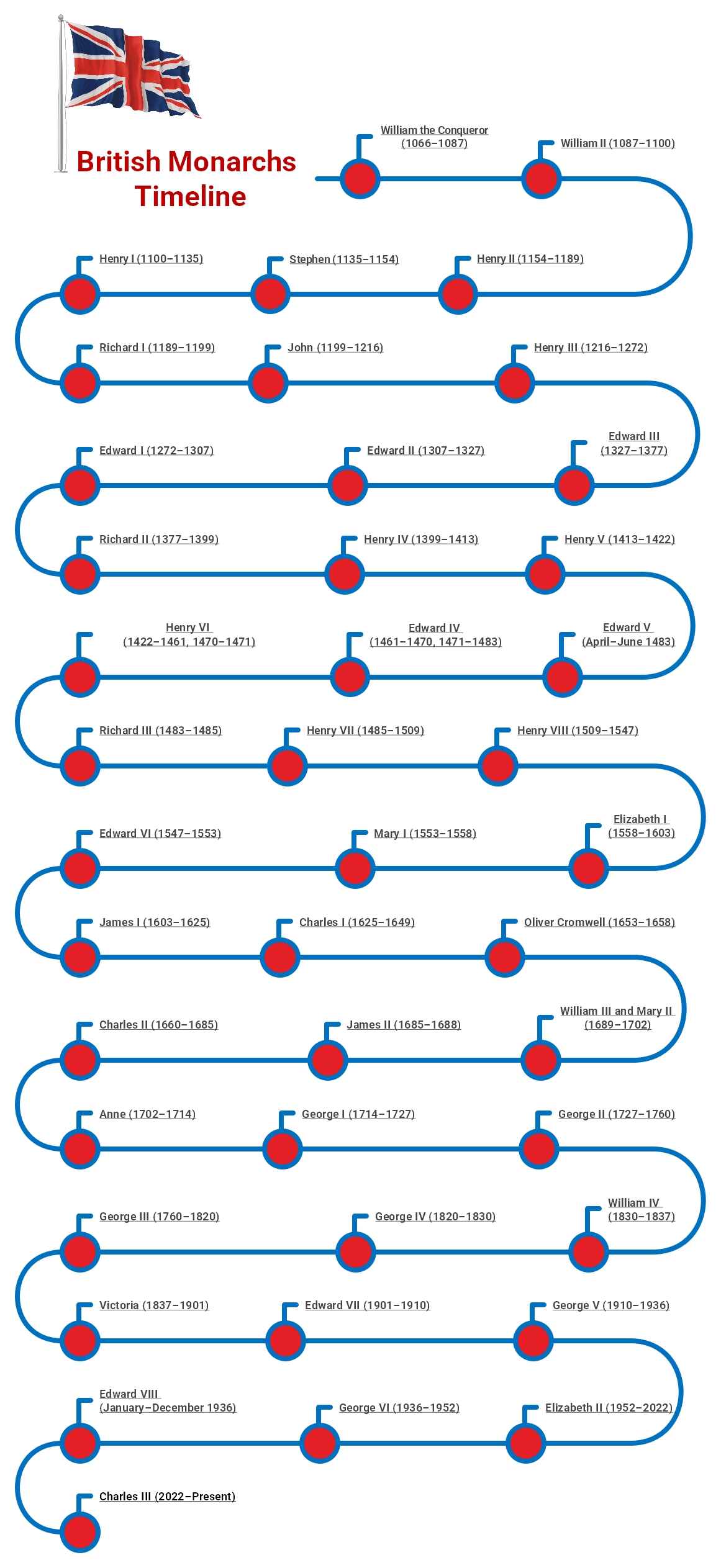You’ve probably heard of kings and queens, but the British monarchy has a truly wild history.
There were warrior kings, child rulers, and queens who changed everything. Some were loved, others... not so much. Over time, the monarchy changed as well. Today, the king or queen is mostly a symbol, while the prime minister runs the country. Still, every monarch left a mark. This timeline takes you through the full royal journey, full of drama, power, and tradition.
In this article
Part 1: English Monarchs Timeline
The United Kingdom is a monarchy, but not like in the old days. Today, the monarch is the head of state, not the one making laws. Real political power belongs to the prime minister and the government. The king or queen follows their advice. That’s how a constitutional monarchy works.
Let’s go back in time and meet them - one by one from William the Conqueror to Charles III.
William the Conqueror (1066–1087)
Everything changed in 1066. William of Normandy defeated King Harold at Hastings and began the House of Normandy. He brought French culture, ordered the Domesday Book, and built massive stone castles. More than just a conqueror, William reshaped England forever, setting the stage for centuries of royal drama and transformation.
William II (1087–1100)
They called him William Rufus. Bold, hot-tempered, and part of the Norman dynasty, he ruled with force. His reign was rocky and ended suddenly with an arrow through the chest during a hunt. Accident? Maybe. Assassination? Possibly. His mysterious death opened the door for his brother Henry to grab the crown.
Henry I (1100–1135)
Henry acted fast. After his brother's sudden death, he claimed the throne and secured power through brains and marriage. The last strong king of the House of Normandy, he modernized the government. But tragedy struck: his only son drowned. With no heir, England teetered on the edge of civil war.
Stephen (1135–1154)
Stephen wasn't the obvious heir, but he took the crown anyway. His cousin Matilda wasn't happy. Their clash sparked "The Anarchy," a brutal civil war where loyalties changed like the wind. Chaos reigned. Eventually, peace returned, but only after Stephen agreed to make Matilda's son his successor.
Henry II (1154–1189)
Smart, fiery, and fiercely ambitious, Henry II launched the Plantagenet dynasty. He restored royal control, reshaped law, and ruled more than just England. But his fight with Archbishop Thomas Becket led to murder in a cathedral. His reign brought power and progress - yet ended in grief, conflict, and family betrayal.
Richard I (1189–1199)
Better known as Richard the Lionheart, he was every inch a warrior king. Crusades, battles, and glory defined his reign, but not in England. He spent little time at home and nearly bankrupted the crown. Still, he died as he lived: sword in hand, in France, admired for his courage.
John (1199–1216)
Not a fan favorite. John, also a Plantagenet, lost lands, raised taxes, and angered everyone. In 1215, the barons had had enough and forced him to sign the Magna Carta. It changed history by limiting royal power. John didn't like it. But he had no choice. A weak reign, a powerful legacy.
Henry III (1216–1272)
Only nine when he became king, Henry III's reign was long but troubled. He loved art and religion, but made poor political calls. Rebellions followed. Parliament began rising. He tried, often failed, and ruled for over 50 years. A gentle spirit, but not a strong hand during England's growing pains.
Edward I (1272–1307)
Strong, sharp, and determined, Edward I aimed to control all of Britain. He conquered Wales and challenged Scotland. Known as "Hammer of the Scots," he also reformed laws and strengthened Parliament. His legacy is mixed: builder, warrior, and reformer. There's no doubt: he left a lasting mark on the kingdom.
Edward II (1307–1327)
Edward II never lived up to his father. Weak in leadership and overly devoted to favorites, he alienated nobles and even his wife. Queen Isabella and her ally eventually deposed him. Forced to abdicate, he died mysteriously in prison. A sad, turbulent reign, and a warning about personal over politics.
Edward III (1327–1377)
Here came a comeback. Edward III brought back glory to the Plantagenets. He launched the Hundred Years' War and crushed his enemies in battle. His reign saw triumph, plague, and the birth of English pride. He ruled for 50 years, balancing war and royalty. But trouble brewed quietly in the background.
Richard II (1377–1399)
A child king with royal flair, Richard II grew into a controlling ruler. He clashed with nobles, taxed heavily, and sparked rebellions. Eventually, his cousin Henry Bolingbroke seized power. Richard lost the crown and likely his life, to prison. His fall marked the end of a dynasty and the rise of another.
Henry IV (1399–1413)
Henry IV wasn't born to be king. He took it. The first Lancastrian monarch, he faced rebellions, illness, and doubts about his right to rule. Still, he held the throne through unrest and paved the way for his son, a future legend. His reign was rocky, but his dynasty was rising.
Henry V (1413–1422)
Bold and battle-ready, Henry V became a national hero. His stunning victory at Agincourt stunned France and thrilled England. A warrior king from the House of Lancaster, he seemed unstoppable. But he died young, just 35. His brief reign is remembered as one of England's brightest, most glorious military chapters.
Henry VI (1422–1461, 1470–1471)
Troubled from the start, Henry VI became king as a baby. He was kind and gentle, not built to rule. He struggled with mental illness and lost control of the kingdom. The Wars of the Roses exploded. He was deposed, restored, and then killed. A tragic figure in a kingdom tearing itself apart.
Edward IV (1461–1470, 1471–1483)
Handsome, confident, and Yorkist to the core, Edward IV took the crown by force. He ruled well, lost it, then won it back. But peace didn't last. After his death, his sons vanished. His dynasty's drama - murder, betrayal, mystery—would haunt the monarchy for centuries. Still, Edward brought brief calm between storms.
Edward V (April–June 1483)
He never wore the crown. Edward V was just 12 when declared king. He and his brother were taken to the Tower and never seen again. Many suspect their uncle Richard. Edward's reign lasted barely two months. A boy lost to history, mystery, and the ruthless politics of royal ambition.
Richard III (1483–1485)
Richard III said he'd protect the throne. Instead, he took it. His short rule was shadowed by the fate of his nephews and constant suspicion. He died in battle, sword in hand, as the Tudor army closed in. His death ended the Plantagenet line, and changed England's royal story forever.
Henry VII (1485–1509)
After years of civil war, Henry VII brought peace by marrying Elizabeth of York - uniting the warring houses. He strengthened royal finances, controlled the nobles, and founded the Tudors. He wasn't flashy, but he was smart. His quiet, careful rule laid the foundation for the Tudor golden age to come.
Henry VIII (1509–1547)
Larger-than-life, Henry VIII changed everything. He had six wives, broke from the Catholic Church, and made himself head of England's new Church. He loved jousts, music, and power. By his death, monasteries were gone, daughters ruled next, and England's identity had changed forever. A king who reshaped the crown.
Edward VI (1547–1553)
Young and devout, Edward VI pushed Protestantism hard. Just a boy, others ruled in his name. Churches changed, Latin vanished, and England looked less Catholic. But he died at 15 - before his plans could stick. His short reign left big questions and opened the door to chaos, ambition, and sharp reversals.
Mary I (1553–1558)
Mary wanted to turn the clock back. A Catholic queen in a Protestant country, she restored old faith, married Philip of Spain, and burned hundreds of dissenters. "Bloody Mary," they called her. But her heart broke with no heir and lost of Calais. A tragic, fiery chapter in Tudor history.
Elizabeth I (1558–1603)
England's Gloriana. Elizabeth ruled alone and with flair. She survived plots, faced the Armada, and never married. Her reign saw Shakespeare, exploration, and pride swell. The last Tudor—but one of the greatest. She walked a tightrope of faith and power, and left behind a legend that still dazzles today.
James I (1603–1625)
First of the Stuarts. James ruled England and Scotland, surviving the Gunpowder Plot and commissioning the King James Bible. He believed in divine right, clashed with Parliament, and loved learning. A peaceful reign on the surface, but tensions bubbled underneath.
Charles I (1625–1649)
He wouldn't compromise. Charles I believed that kings answered only to God. He dissolved Parliament, taxed alone, and finally sparked civil war. England executed its king after a trial. A dramatic fall for the divine monarchy. His death shook the throne to its core and left Britain searching for balance and a future.
Oliver Cromwell (1653–1658)
Not a king - but he ruled. Cromwell led Parliament's forces to victory, executed Charles, and created the Commonwealth. As Lord Protector, he banned fun, crushed Ireland, and shocked monarchists. A devout Puritan, a strong leader, a controversial figure. When he died, the monarchy didn't wait long to come storming back.
Charles II (1660–1685)
The Merry Monarch. Charles II came back laughing after years in exile. He reopened theaters, dealt with plague and fire, and ruled with charm. But he played a double game; with France, with Parliament, with mistresses. He died without an heir, but left England smiling, stable, and slightly suspicious again.
James II (1685–1688)
He pushed too hard. James II was Catholic in a Protestant country and tried to change it fast. Parliament revolted. His daughter and her husband took over. No execution—just escape. The Glorious Revolution ended his reign and reshaped the monarchy forever. Kings now ruled with Parliament, not without it.
William III and Mary II (1689–1702)
A joint crown; rare, but it worked. William and Mary ruled after James fled. They accepted Parliament's power, signed the Bill of Rights, and fought off threats from France and Scotland. Mary died early. William ruled alone. Together, they secured Protestant succession—and a monarchy forever changed by Parliament's voice.
Anne (1702–1714)
The last Stuart. Anne saw England and Scotland unite as Great Britain. Her reign brought war abroad and shifted politics at home. Many pregnancies—no surviving heirs. She loved her friends, hated politics, and died with a dynasty's end. After her, a German cousin would cross the sea to rule.
George I (1714–1727)
He barely spoke English. George I, first of the Hanoverians, ruled from afar, and let Parliament lead. Britain's first Prime Minister rose. He preferred Hanover, struggled with scandal, and wasn't loved. But the monarchy survived, and changed. Kings would now rule less and reign more. Power was moving, but the crown stayed put.
George II (1727–1760)
War, music, and more Hanover drama. George II saw battles abroad, Handel's music rise, and Jacobites rebel. He argued with his son and let ministers govern. Still, Britain grew. He was the last king born outside England, but left behind a throne now firmly grounded in British politics.
George III (1760–1820)
He tried to be a good king. George III ruled long, lost America, and went mad. He loved farming, kept tradition, and fought France. The crown stayed strong, but change stirred. Parliament grew bolder. By the end, the monarchy was more symbol than power. And George lived in a silent retreat.
George IV (1820–1830)
The Regent-turned-King loved luxury. George IV was stylish, selfish, and scandalous. He built Brighton's Pavilion, but ruled poorly. His marriage was a disaster, and his health was worse. The people mocked him, Parliament limited him, and his reign ended without love. Still, he left a mark—just not the one he wanted.
William IV (1830–1837)
Sailor King, short reign. William IV witnessed the passage of the Reform Act, which expanded the vote and altered the course of politics. He liked a simple life, disliked pomp, and ruled during transition. No heirs, but steady hands. He helped the monarchy move forward, quietly, cautiously—before handing the throne to a young niece with a name history remembers.
Victoria (1837–1901)
A girl became a symbol. Queen Victoria ruled through empire, industry, and sorrow. She lost Albert young and never stopped mourning. Under her, Britain grew mighty. She wasn't always warm, but she always watched. Her name defined an era—and when she died, the world had changed beyond all recognition.
Edward VII (1901–1910)
After waiting decades, Edward VII finally wore the crown. He was charming, worldly, and loved diplomacy. His short reign helped modernize the monarchy and Britain's place in Europe. Style, travel, and politics mixed under his watch. The sun still shone on the empire, but clouds of war gathered just beyond the horizon.
George V (1910–1936)
Duty defined him. George V guided Britain through World War I, dropped German titles, and saw revolution sweep Europe. He steadied the monarchy, survived global change, and shaped a modern royal image. Quiet, firm, and deeply loyal, he earned respect and passed on a crown under growing pressure and spotlight.
Edward VIII (January–December 1936)
He loved a woman more than the crown. Edward VIII abdicated to marry Wallis Simpson—an American, divorced, unacceptable to Britain. His reign barely began. Tradition cracked. His brother took over. He became the Duke of Windsor, exiled and watched. A love story? Maybe. A constitutional crisis? Absolutely. The monarchy was shaken.
George VI (1936–1952)
Unexpected king, steady soul. George VI rose after his brother's shock abdication. He led Britain through war, bombs, and blackouts with quiet courage. He stammered—but never stumbled. The empire began fading. Modernity arrived. He died young, and mourned deeply. His daughter would take the crown—and the monarchy would change forever again.
Elizabeth II (1952–2022)
The longest reign. Elizabeth II became queen at 25 and ruled through a century's change. Wars, tech, scandal, space, and selfies—she saw it all. Always calm. Always there. Through grief, joy, and global attention, she stayed constant. Her platinum reign ended a second Elizabethan age. History stood still when she passed.
Charles III (2022– Present)
At last, the crown is his. Charles III waited decades, weathered scandal, and reshaped his image. As king, he faces a modern world: climate change, diversity, and divided politics. He blends tradition with activism. His reign begins with both sorrow and hope. A new chapter unfolds—for him, and for Britain.
Part 2: How to Make the British Monarchs Timeline using EdrawMind?
EdrawMind is a user-friendly diagramming tool compatible with iOS, Windows, Mac, and Android. The best part? It has hundreds of built-in templates for all diagrams, including timelines and mind maps. So, you can pick a template, customize it, and save it as your own project.
That said, let's look at making the British Monarchs timeline with EdrawMind:
Step 1: Getting Started
- Install and start EdrawMind.
- Alternatively, try out EdrawMind online on your browser
- Log in with a social account or create a new one for free.
- Click the New Mindmap button on the homescreen to open a new file.
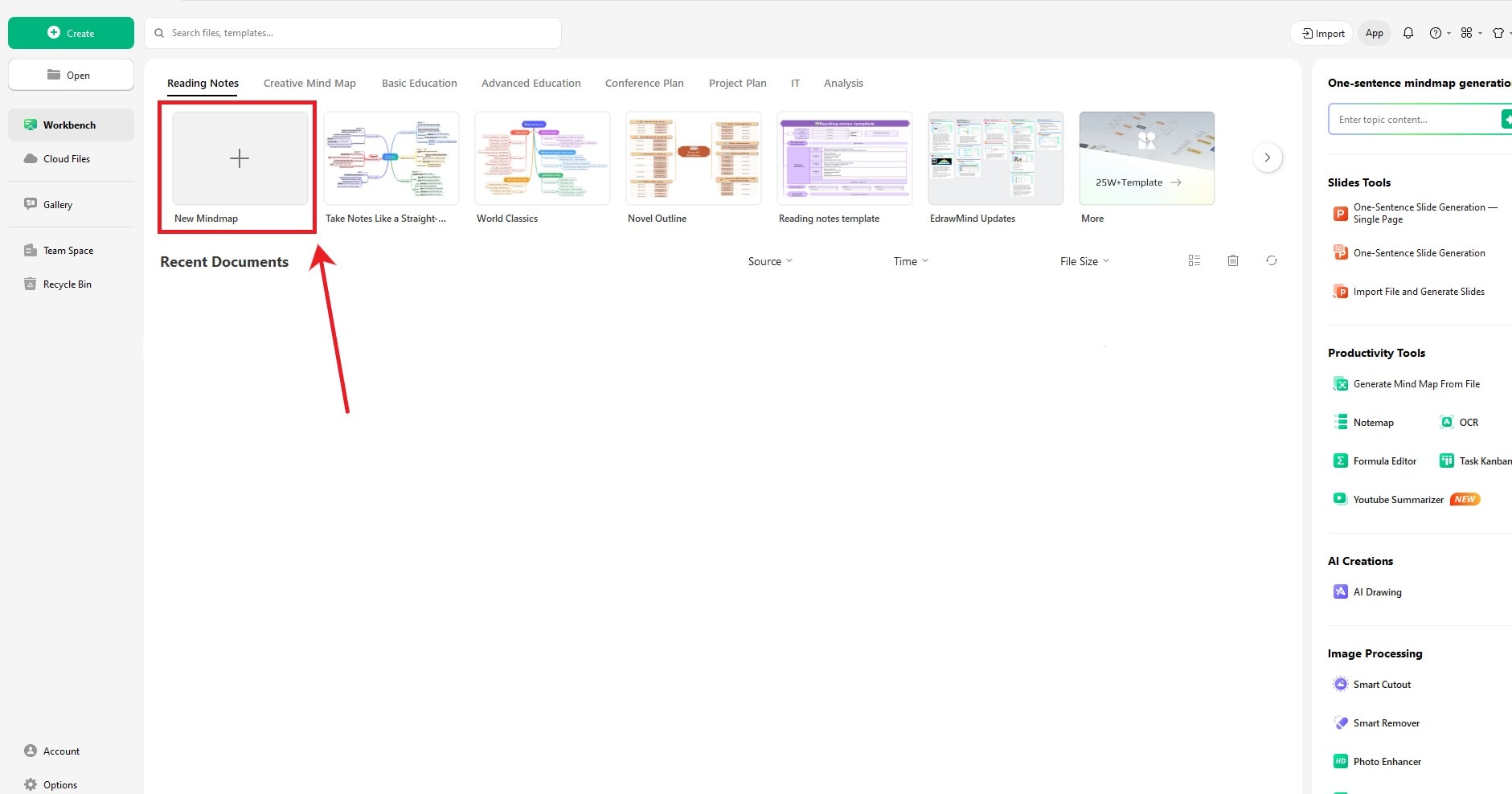
Step 2: Change to Timeline Layout
- Click the Main Idea and go to Layout from the floating menu.
- Select Timeline (S-shape) from the list.
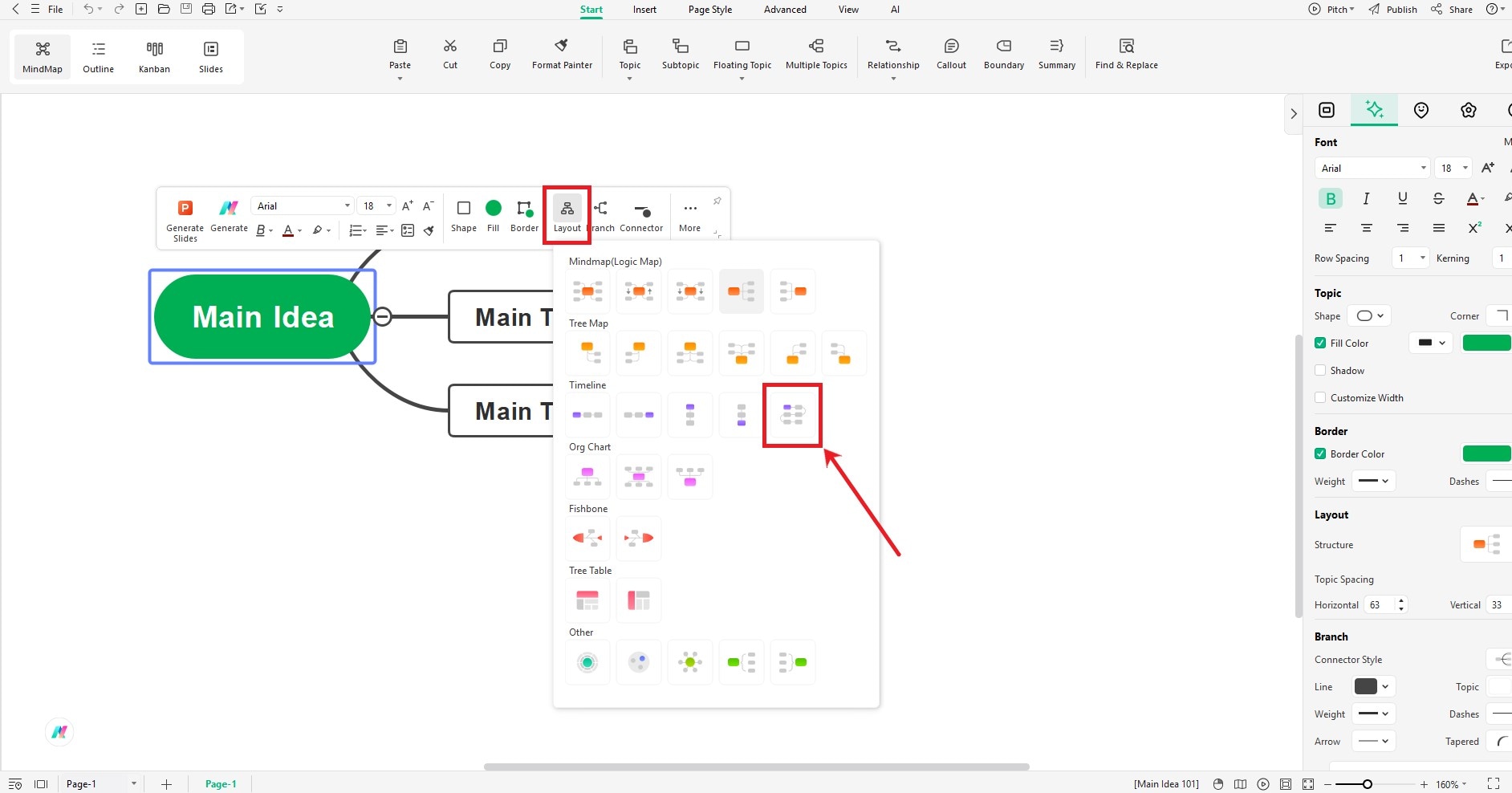
Step 3: Expand the Timeline
- Click the Main Idea and go to More from the floating menu. Now, select Topic from the drop-down menu to add a new entry.
- Similarly, select a Main Topic, go to More, and click Subtopic.
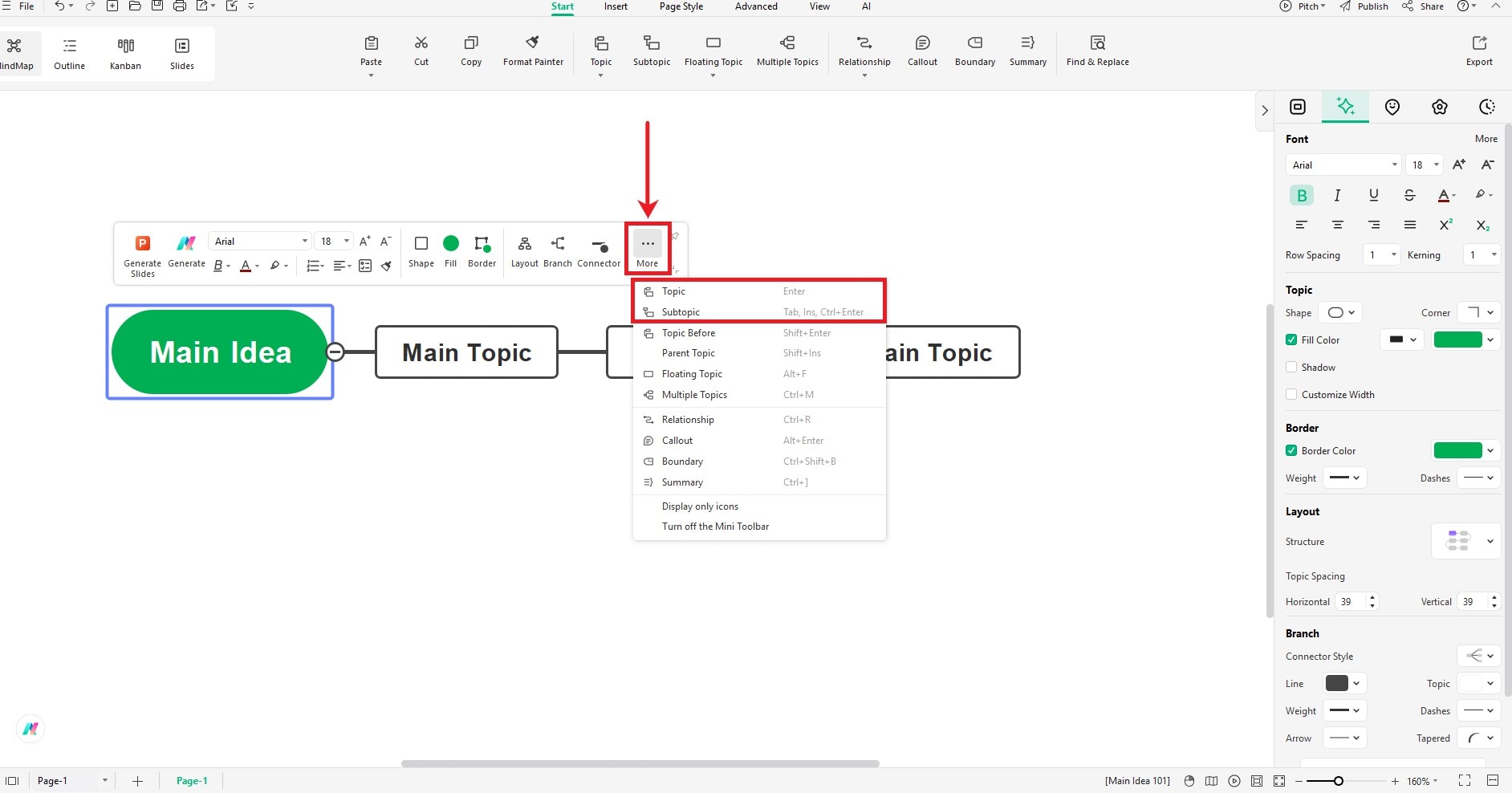
Step 4: Change the Timeline Design
- Click a topic and customize its shape, color, style, border, and branch settings from the floating menu.
- Use the right toolbar for in-depth customization.
- Double-click any topic to change its text content. Then, use the floating menu and the right toolbar to customize the font.
- Pro-tip: You can also customize multiple topics at once by selecting them.

Step 5: Add an Image
- You can also add images to make the timeline more engaging. Download an image or copy it and paste it into EdrawMind.
- Drag and drop it into a topic. Use the floating menu and the right toolbar to change image settings.
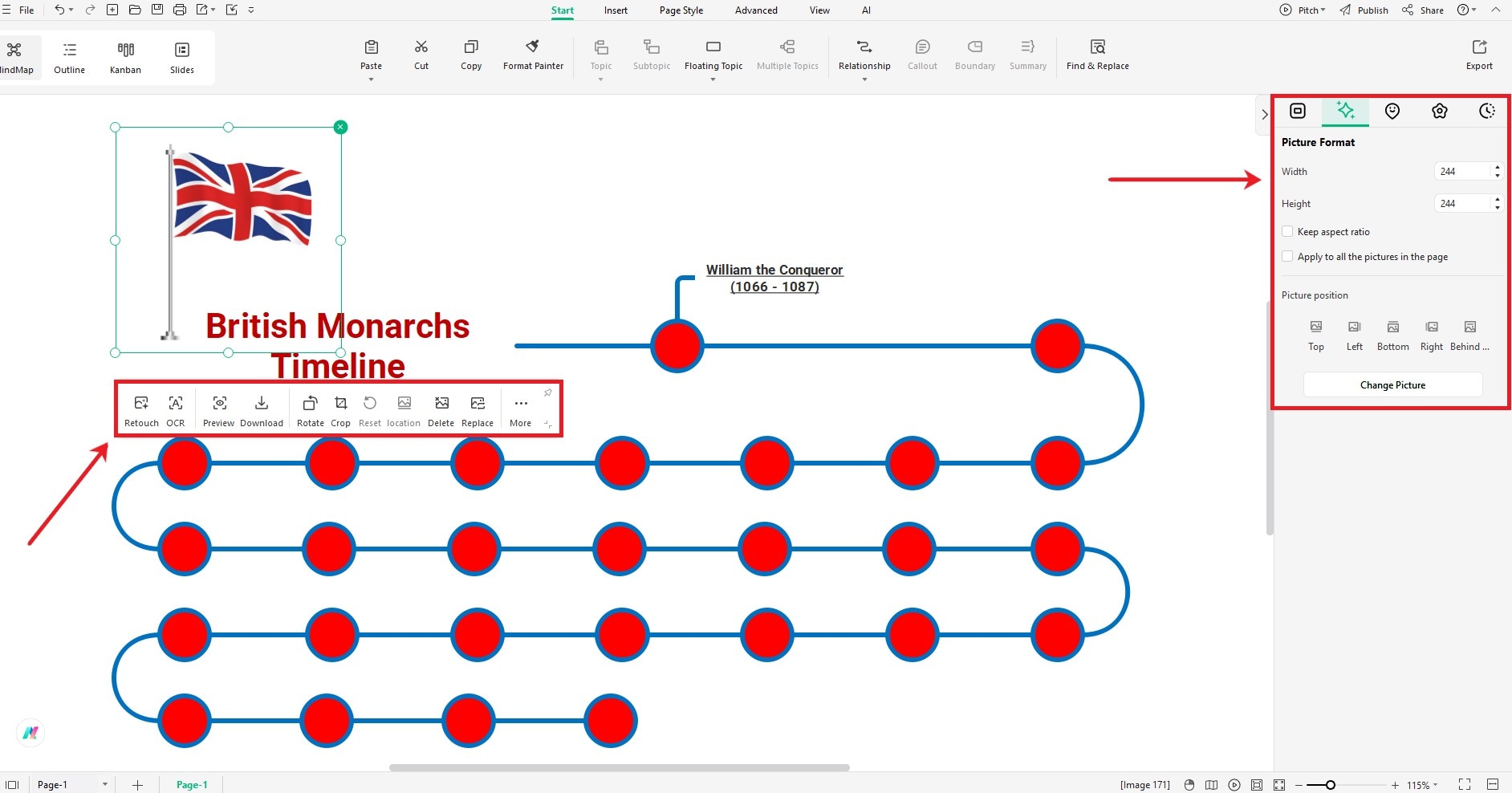
Step 6: Save the Timeline
- All set?
- Click the File button with the hamburger icon at the top-left corner.
- Click Save to download the file.
- Pro-tip: You can also choose the file format by clicking Export to export in PNG, JPG, PPT, PDF, and more formats.
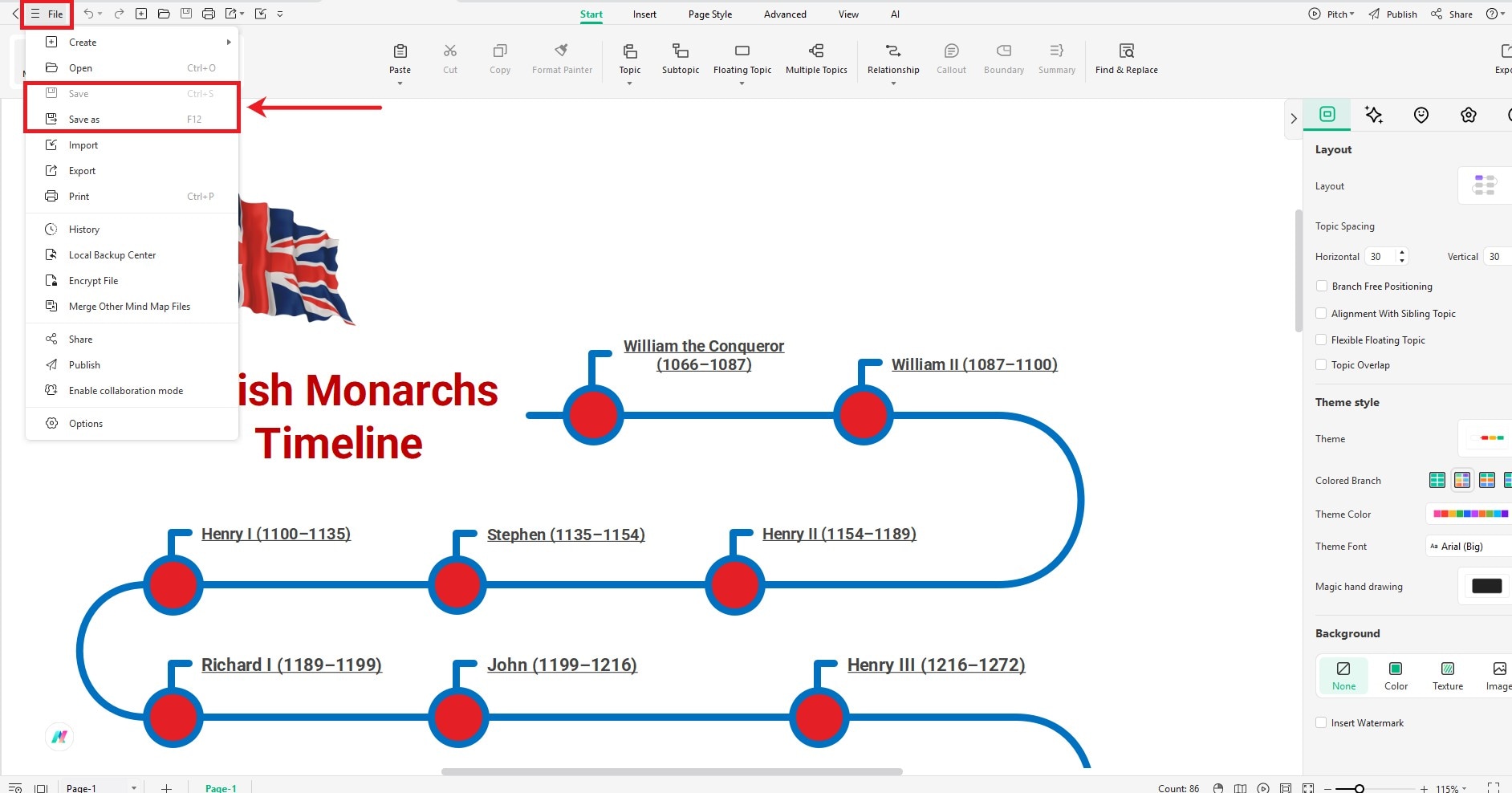
The Future of Royal Legacy
If you made it this far - congrats! You've walked through nearly 1,000 years of kings, queens, wars, peace, drama, and change. From William the Conqueror to Charles III, each monarch left a mark. The crown may not rule like it once did, but it still matters today - and its story isn't over.
Want to see the whole timeline in one glance? Try EdrawMind. It's perfect for turning big topics like this into simple, visual stories.



